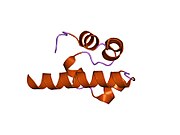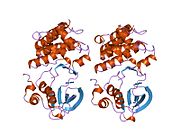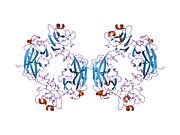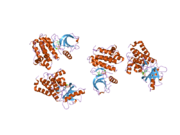EPH receptor B2
Ensembl | |||||||||
|---|---|---|---|---|---|---|---|---|---|
| UniProt | |||||||||
| RefSeq (mRNA) | |||||||||
| RefSeq (protein) | |||||||||
| Location (UCSC) | Chr 1: 22.71 – 22.92 Mb | Chr 4: 136.37 – 136.56 Mb | |||||||
| PubMed search | [3] | [4] | |||||||
| View/Edit Human | View/Edit Mouse |
Ephrin type-B receptor 2 is a protein that in humans is encoded by the EPHB2 gene.[5]
Function
Ephrin receptors and their ligands, the ephrins, mediate numerous developmental processes, particularly in the nervous system. Based on their structures and sequence relationships, ephrins are divided into the ephrin-A (EFNA) class, which are anchored to the membrane by a glycosylphosphatidylinositol linkage, and the ephrin-B (EFNB) class, which are transmembrane proteins. The Eph family of receptors are divided into 2 groups based on the similarity of their extracellular domain sequences and their affinities for binding ephrin-A and ephrin-B ligands. Ephrin receptors make up the largest subgroup of the receptor tyrosine kinase (RTK) family. The protein encoded by this gene is a receptor for ephrin-B family members.[6]
Animal studies
EphB2 is part of the
animal model of Alzheimer's disease.[7]
A
pigeons.[8]
Interactions
EPH receptor B2 has been shown to
interact
with:
- Abl gene[9]
- RAS p21 protein activator 1[10]
References
- ^ a b c GRCh38: Ensembl release 89: ENSG00000133216 – Ensembl, May 2017
- ^ a b c GRCm38: Ensembl release 89: ENSMUSG00000028664 – Ensembl, May 2017
- ^ "Human PubMed Reference:". National Center for Biotechnology Information, U.S. National Library of Medicine.
- ^ "Mouse PubMed Reference:". National Center for Biotechnology Information, U.S. National Library of Medicine.
- PMID 1648701.
- ^ "Entrez Gene: EPHB2 EPH receptor B2".
- PMID 21113149.
- "Protein provides Alzheimer's clue". NHS Choices. November 29, 2010. Archived from the original on 2011-05-18.
- PMID 23371554.
- Carl Zimmer (February 4, 2013). "Pigeons Get a New Look". The New York Times.
- PMID 11494128.
- PMID 9233798.
- PMID 9632142.
- PMID 10644995.








